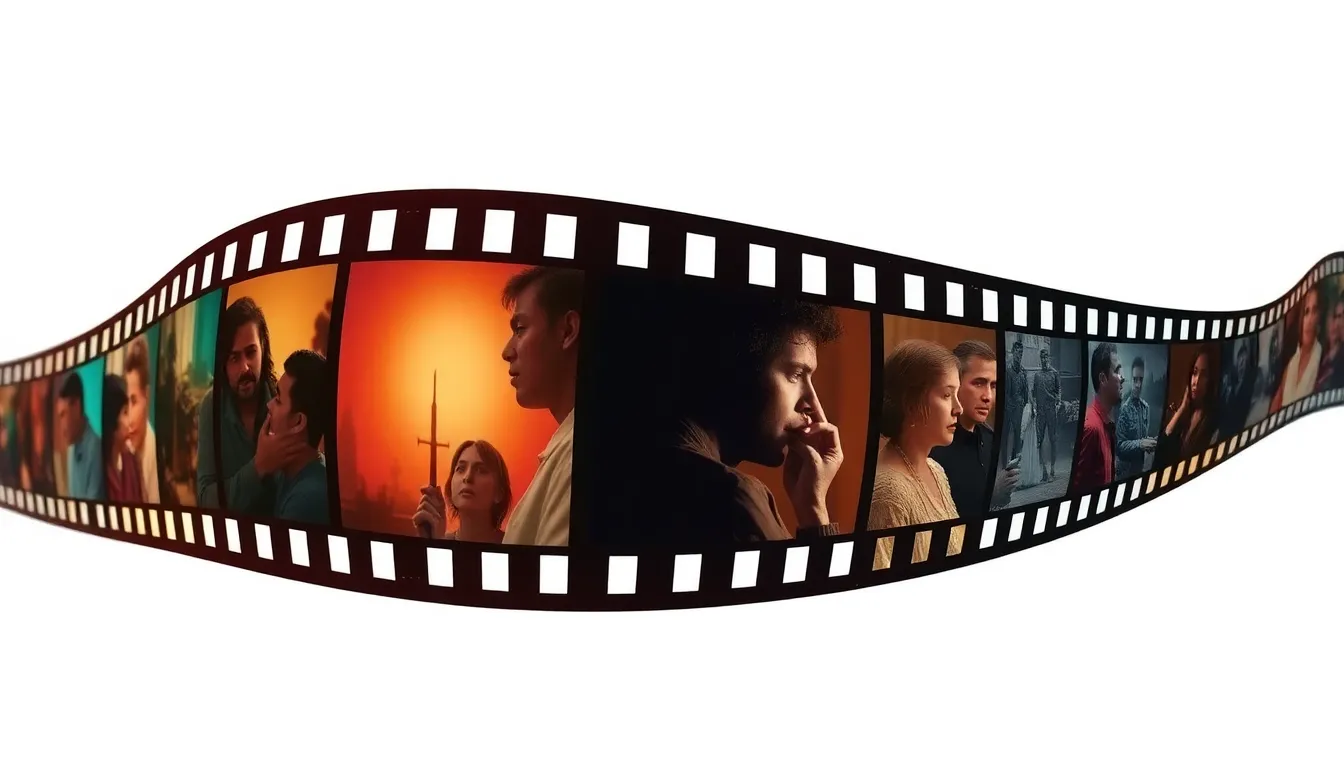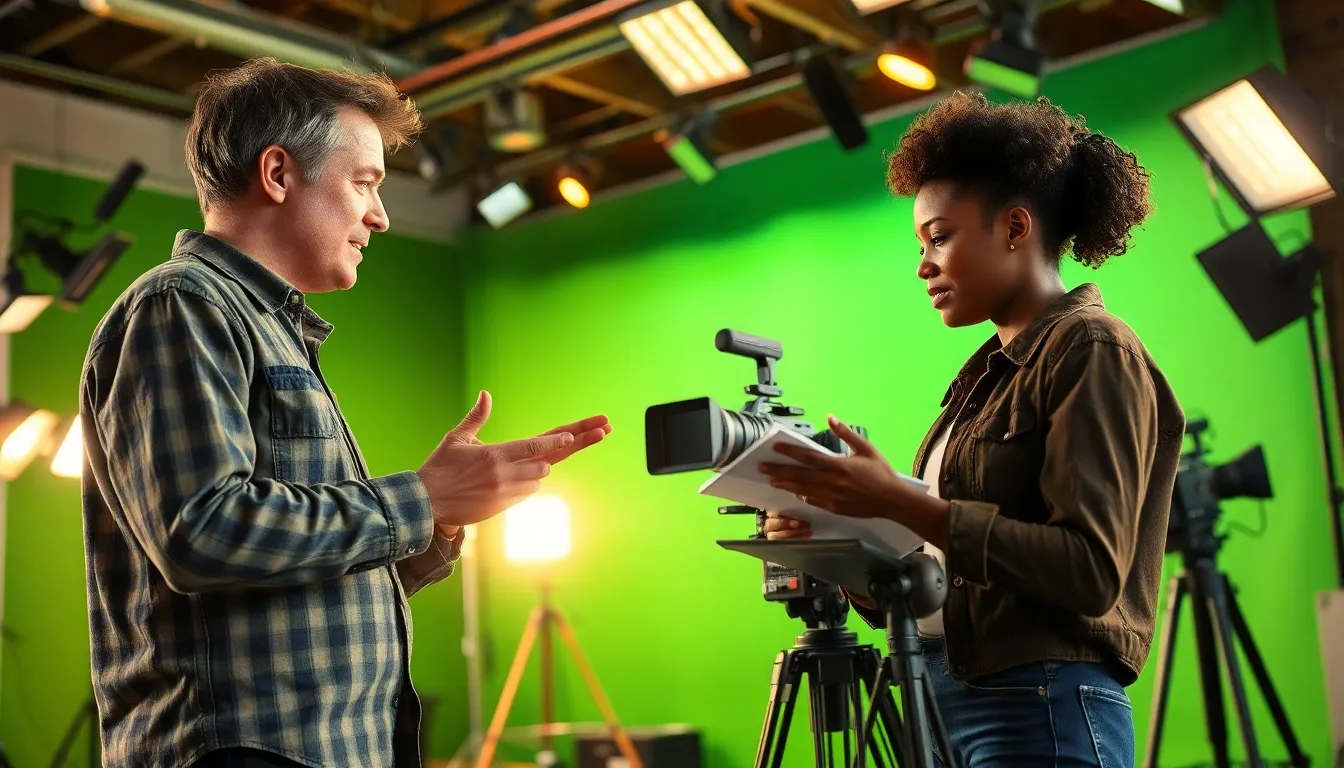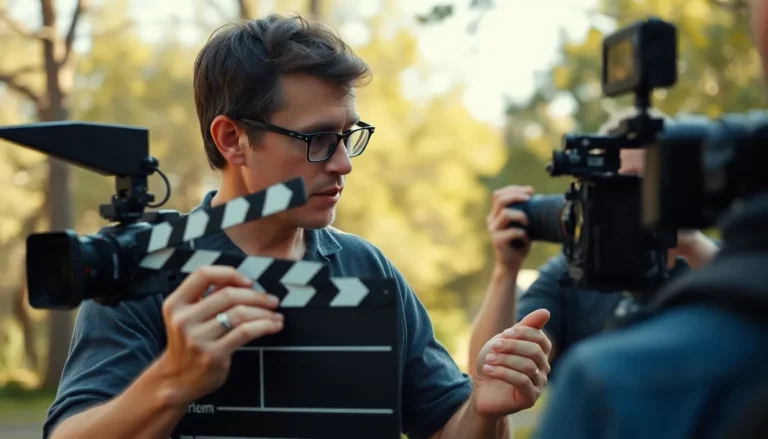Films are more than just moving pictures; they’re intricate tapestries woven with narrative techniques that keep audiences glued to their seats. From clever twists to unreliable narrators, these storytelling methods can turn a simple plot into a rollercoaster of emotions. Ever wondered how that one movie made you laugh, cry, and question your life choices all in one sitting? It’s all thanks to the artful use of narrative techniques.
As filmmakers play with time, perspective, and structure, they create experiences that resonate long after the credits roll. Whether it’s a flashback that reveals a character’s hidden past or a nonlinear storyline that keeps viewers guessing, these techniques are the secret sauce that elevates a film from ordinary to unforgettable. Dive in and discover how these narrative gems shape the stories we love and why they matter more than you might think.
Table of Contents
ToggleOverview of Narrative Techniques in Film
Narrative techniques play a crucial role in shaping the storytelling landscape of film. Filmmakers utilize various methods to craft intricate plots that captivate audiences. Clever twists in the story often keep viewers engaged and on the edge of their seats. Unreliable narrators add layers of complexity, inviting audiences to question the truth of the narrative.
Manipulation of time enhances the storytelling process, allowing filmmakers to present events non-linearly. Flashbacks and flash-forwards create a dynamic experience, enriching character development and plot progression. Perspective shifts also provide fresh insights into the narrative, enabling viewers to understand different characters’ motivations.
Transmedia storytelling further extends narrative techniques beyond traditional films. By incorporating various media platforms, filmmakers can deepen audience engagement and explore storylines from multiple angles. Visual storytelling elements like symbolism and cinematography elevate the narrative, enhancing emotional responses.
Dialogue serves as another vital component, revealing character traits and advancing plot. Strong character development through dialogue engages audiences, making them more invested in the story. Additionally, sound design and music can convey emotions, aligning the audience’s feelings with the narrative.
Visually, editing techniques contribute significantly to pacing and rhythm, establishing the film’s overall tone. Jump cuts can create urgency, while longer takes often build suspense.
Understanding these narrative techniques enables viewers to appreciate the artistry behind filmmaking. They play an essential role in transforming basic narratives into emotionally charged experiences that resonate long after the credits roll.
Types of Narrative Techniques

Narrative techniques play a crucial role in shaping a film’s storytelling approach. Various methods enhance viewer engagement and emotional connection.
Linear Narrative
A linear narrative unfolds events in chronological order, presenting a straightforward progression of time. Films like “The Pursuit of Happyness” exemplify this technique, allowing audiences to follow characters’ journeys seamlessly. Viewers experience the story as events build upon one another, facilitating easy comprehension. This structure often leads to satisfying resolutions, as audiences witness character arcs develop from beginning to end. The clear timeline also aids in creating tension and anticipation, making the narrative experience more immersive.
Non-linear Narrative
In contrast, a non-linear narrative jumps around in time, presenting events out of chronological sequence. Films such as “Pulp Fiction” illustrate this technique by interweaving various storylines. Audiences can develop a deeper understanding of character motivations as they discover the connections between different scenes. This method invites viewers to actively solve the narrative puzzle, enhancing engagement. Flashbacks and flash-forwards can enrich the storytelling experience, revealing crucial information at strategic moments. The unpredictability of a non-linear format keeps audiences intrigued and invested.
Fragmented Narrative
A fragmented narrative presents a story in disjointed segments, creating a tapestry of interrelated moments. This technique often highlights emotional resonance over chronological consistency. Films like “Eternal Sunshine of the Spotless Mind” showcase how fragmented storytelling can reflect characters’ inner thoughts and memories. Audiences experience a blend of past and present, deepening their connection to the narrative. Fragmented narratives often challenge viewers to piece together the larger story, fostering critical thinking. This approach can evoke powerful emotional reactions, allowing for a profound exploration of themes and character development.
Character Development in Film
Character development plays a crucial role in enhancing a film’s narrative. It shapes the audience’s emotional connection to the story through well-crafted arcs.
Protagonist and Antagonist Arcs
Protagonist arcs demonstrate the character’s journey, showcasing growth and change. For example, in “The Pursuit of Happyness,” Chris Gardner evolves from despair to hope, which resonates deeply with viewers. Antagonist arcs also contribute significantly by providing conflict and challenge. In “Star Wars,” Darth Vader transitions from villain to a redeemed figure, adding complexity to the narrative. These character arcs not only drive the plot forward but also offer insights into human nature, making the story more impactful.
Supporting Characters
Supporting characters enrich the narrative by complementing main characters and adding depth. For instance, in “The Lord of the Rings,” characters like Samwise Gamgee provide loyalty and friendship, emphasizing themes of bravery. They also serve as catalysts for the protagonist’s growth. Well-developed supporting characters can evoke empathy and create compelling subplots. In “Little Miss Sunshine,” each family member’s quirks contribute to the overarching theme of acceptance and resilience, enhancing the film’s emotional layers.
Visual Storytelling
Visual storytelling combines various elements to create a compelling narrative on screen. Techniques such as cinematography and lighting contribute significantly to how stories are conveyed and perceived.
Cinematography and Composition
Cinematography emphasizes the art of capturing images on film. Framing choices dictate how viewers perceive characters and actions, allowing for focused attention on specific elements. For example, close-up shots reveal emotions, while wide shots establish context and scale. Composition techniques guide viewer engagement, leading to memorable moments that resonate. Shots like the rule of thirds enhance visual balance, making scenes aesthetically pleasing. Camera angles shift perspective, creating tension or intimacy in scenes. Such strategies deepen the viewer’s connection to the narrative, enriching the overall cinematic experience.
Color and Lighting Techniques
Color and lighting play vital roles in setting mood and atmosphere. Specific color palettes evoke emotions, with warm tones suggesting comfort and cool tones indicating tension. For instance, films like “Se7en” use desaturated colors to convey bleakness and despair. Lighting techniques can also influence narrative interpretation; high-key lighting produces a bright, cheerful ambiance while low-key lighting creates suspense or mystery. Shadows shape perceptions of characters, enhancing the story’s emotional depth. Through thoughtful use of color and lighting, filmmakers craft an immersive viewing experience that amplifies the unfolding narrative.
Narrative techniques play a pivotal role in shaping the cinematic experience. By employing various storytelling methods filmmakers can craft engaging and emotionally resonant narratives that captivate audiences. The blend of character development visual storytelling and innovative editing techniques enhances the depth of films and fosters a stronger connection between viewers and the story.
As the landscape of filmmaking evolves transmedia storytelling offers exciting possibilities for expanding narratives across different platforms. This approach invites audiences to immerse themselves further into the story world. Ultimately the mastery of narrative techniques not only elevates individual films but also enriches the entire art of storytelling in cinema.




